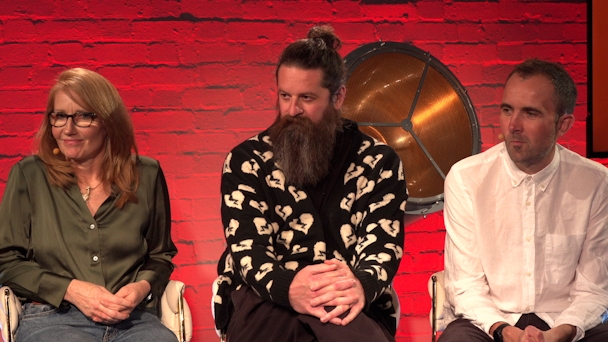Domino’s, Beavertown & Kantar share secrets of compelling food & drink marketing
Only food and drinks brands that adapt rapidly to change and create innovative strategies to grow brand loyalty, build engagement and drive sales will survive in the ‘new normal’ was the conclusion of marketers from Domino’s, Beavertown Brewery and Kantar at The Drum Live.

Domino's Louise Pilkington, Tom Rainsford of Beavertown Brewery and Kantar's Andrew Walker
Joining The Drum for Savoring Success: The Secrets of Compelling Food and Drink Marketing were Louise Pilkington, the innovation director at pizza giant Domino’s, Tom Rainsford, who is marketing director at craft beer brand Beavertown, and Andrew Walker, senior commercial partner at Kantar’s World Panel, which researches the purchase habits of millions of consumers around the world to help brands create effective marketing and sales strategies.
From shifting food delivery habits to the impact of own-label products, food and drink brands and businesses face an unprecedented need for innovation and adaptability in order to continue reaching the consumers who helped them build successful businesses and brands in the first place.
Want to go deeper? Ask The Drum
The new normal
Reflecting on her time at Domino’s post-lockdown, innovation director Louise Pilkington emphasized the huge shift in how consumers engage with convenience food brands such as Domino’s in what she terms as the ‘new normal’ – a time where people readily recognize they have less disposable income for takeaway foods while also recognizing that choices are far broader than ever before.
Pilkington said: “People’s habits just totally changed in terms of ordering food. Then we had a complete digital revolution, supported by aggregators such as Just Eat.” This transformation introduced an overwhelming array of choices, making it essential for brands to adapt swiftly.
Pilkington added that with today’s heightened competition and the impact of rising living costs, brands must fight to capture the attention of consumers, who now have less disposable income. “We raised our game in terms of innovation,” she explained, “focusing on creating exciting experiences that keep Domino’s relevant while also thinking about how to engage younger, tech-savvy audiences who consume content in entirely different ways.”
On the evolution of the beer and brewing sector, Beavertown’s Rainsford noted the tension between the established brewing giants and emerging craft brands such as Beavertown. “If we rewind a decade, you had big, glorious beer brands that everyone knew, but craft beer disrupted that,” he explained.
However, even craft beer has become mainstream, leading to new challenges. Rainsford highlighted the importance of staying authentic, saying: “There’s always a new challenger coming up, so how do we navigate that while staying true to the brand?” He stressed the need for a product portfolio that remains relevant both today and in the future, without merely chasing fads.
Kantar’s Andrew Walker brought a data-driven perspective to the discussion, focusing on consumer behaviors in the UK food and drink market. He observes that many shoppers have shifted towards discount retailers and own-label products during the cost of living crisis, presenting a tough challenge for brands. “Brands have to work hard to shake people out of those habits,” he noted, emphasizing the difficulty of convincing consumers to pay more for branded goods when they’re content with cheaper alternatives.
Advertisement
Measuring success
Naturally, food and drink brands are searching out creative ways to succeed in today’s challenging marketing environment, leveraging innovation, humor, and authenticity to build deeper engagement with their consumers.
For Domino’s, Pilkington highlighted their recent ‘lunch’ campaign as a particular success. Traditionally seen as a dinner or late-night treat option, Domino’s shifted perceptions with a £4 lunch offering featuring lighter, lower-calorie options. “Our £4 lunch campaign was hugely successful,” said Pilkington, emphasizing how it broadened the brand’s appeal while maintaining its identity. The campaign communicated both value and the brand’s personality, becoming Domino’s strongest brand-building effort to date.
Rainsford’s experience in the beer sector reveals how brands can grow while staying true to their real identity, which is incredibly important in the craft beer sector. Having started from zero marketing, Beavertown expanded successfully by entering new distribution channels while retaining its unique, human-centered appeal.
“The world doesn’t need us to do the same thing as lots of other brands,” Rainsford said, stressing their efforts to stand out. A recent above-the-line campaign featuring real-life stories of pub experiences brought to life through animation maintained the brand’s distinctive, human essence. Rainsford underscores the importance of keeping their “magic” as they grow, focusing on creativity and authenticity.
In terms of social media, Domino’s achieved remarkable success with a stunt delivered socially during a cold snap. Their team created a heat suit made of the same material that keeps its pizzas warm during delivery, generating a huge social buzz for the brand. “It got 1.5m impressions and loads of coverage,” Pilkington explained, highlighting the campaign’s engagement and how it embodied the brand’s playful approach. This stunt even won a Bronze Lion award, underscoring its success in connecting with audiences in an entertaining and relevant way.
Advertisement
Stealing the social limelight
Not to be left behind, Beavertown has also carved out a number of interesting social trends that consumers have happily indulged in and that contribute to building brand loyalty for the brand. If you have ever seen a brightly decorated Beavertown pint glass in a bar and wanted to take it home, you aren’t alone. Thousands are stolen every month and Rainsford embraces it seeing it as a unique way to build brand loyalty and visibility.
“We are the most stolen pint glass in the country,” Rainsford joked and, surprisingly, he fully supports that trend. For Rainsford, each stolen glass serves as a low-cost reminder of the brand in people’s homes. He explains: “When you’re reminded of a brand every time you go and have a glass of water in the morning, that’s a fantastic place for us to be.”
This organic spread of Beavertown glasses reinforces brand awareness in an everyday setting, creating a natural buzz that people love to share on social media, especially through TikToks. Rainsford appreciates this ‘free’ grassroots marketing but actively avoids the brand itself getting involved in artificially amplifying it, stating, “If we do, we kill it.” By letting the fandom grow authentically, the brand maintains its cultural relevance, supported by pop-up shops, tattoos, and other fan-driven activities.
Suggested newsletters for you
Brand Collaborations
Brand collaborations are becoming increasingly popular as food and drinks brands look to build and borrow profile and loyalty from complimentary and relevant brands. As Pilkington explained, Domino’s approach to brand collaborations focuses on finding the right partner, timing, and innovation to create something unique and exciting. Its successful collaboration with Cadbury’s Creme Egg is a prime example. Pilkington described how the pairing of Domino’s cookie dough with an iconic Creme Egg resonated with both brands’ demographics, particularly around Easter, a time associated with indulgence. “It was kind of about picking the right partner at the right time,” Pilkington explains, adding that the disruptive nature of the product – no one had done it before – made it even more appealing.
Pilkington explained that the collaboration generated 15m impressions and the product itself sold out in just two weeks, showcasing the power of getting it right. However, setting up these partnerships is far from easy, she said. Pilkington acknowledged the challenges, particularly when two major brands are involved, each wanting to protect its identity. It took two years and several false starts before the Cadbury’s product was launched, but the persistence paid off. “Eventually, we made a magical baby together,” Pilkington said, emphasizing the genuine value of collaboration – when it’s done well.
The future
In conclusion, the future for food and drinks brands and the marketing of them lies in innovation and adapting to changing consumer behaviors. Pilkington emphasizes the need to attract the next generation, ensuring Domino’s stays relevant: “We are already thinking about what the world of food looks like in 2027.” She highlights the importance of not taking brand loyalty for granted and staying ahead of trends in how people consume media and buy food. Rainsford adds, “We want to give people great products,” underscoring the continued focus on quality at Beavertown Brewery.
Kantar’s Walker had the last word, however, suggesting that the industry itself often shapes consumer preferences: “Consumers don’t know what they want until you give it to them.” He believes brands should focus on identifying underserved needs in their categories to shape future trends rather than simply reacting to consumer demands.
